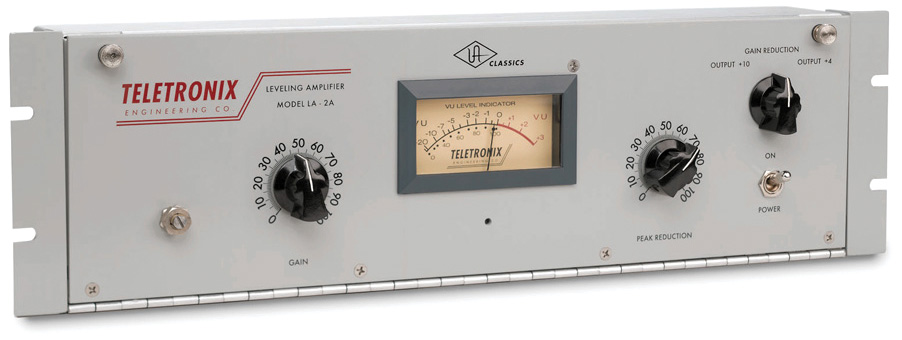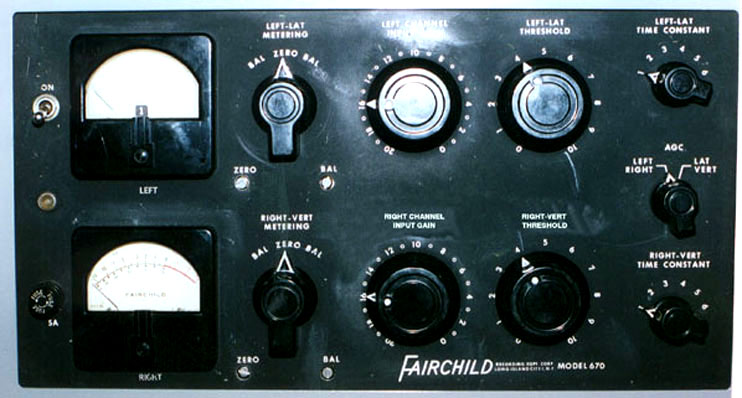| Author | Message | ||
| artswork99
Moderator Username: artswork99 Post Number: 1603 Registered: 7-2007 |
Earlier this year I placed a compressor into the mix. I asked a friend with experience for an initial setting on the compressor and this was how it was explained. A compressor is moving the sound front to back as panning is moving it left to right. It was suggested that I begin with the settings below which have been quite effective but I was wondering about the way others are using compressors in their rigs. Any suggestions to setup and/or explanations of the effect that each of the settings has would be appreciated (the manual didn't do it very good for me). Threshold -1 to -2 Ratio 2 Attack 5 Release 0.1 I also found this in my notes: Try this to get a starting point. Set the attack and release times as fast as they can go and crank up the ratio all the way. Adjust the threshold till the compressor is constantly toggling between no compression and moderate compression. Adjust the attack time till the sound has the bite you want while adjust the threshold to keep that compressor constantly clamping and letting go. Then, adjust the release to get the smoothness you want. Finally, reduce the ratio till you get the amount of compression you want and perhaps a final little touch to the threshold. As the last step, set the makeup gain so that the apparent loudness with and without the compressor are about the same. I didn't have as much success with the notes above as I did with the outright suggested settings... so the settings it's been with a minor adjustment here and there. How are you using your compressor? Thanks for any and all input. Art (Message edited by artswork99 on October 28, 2011) | ||
| mario_farufyno
Senior Member Username: mario_farufyno Post Number: 737 Registered: 9-2008 |
Think about a Compressor as some kind of auto-volume control. It works taming dynamics, or reducing the difference between average level and signal peaks of a Instrument or Microphone. This allows us to raise our Instrument level without clipping the peaks and levelling plucking differences during execution. It works putting down a signal that exceeded a predefined level, that level is called Threshold. In some you can adjust input level to make the peaks surpass a fixed Threshold, in others you can control the Treshold to let it slightly below signal peaks. That way you can set the Compressor to only control those peaks and let average level unprocessed. (Message edited by mario farufyno on October 29, 2011) | ||
| mario_farufyno
Senior Member Username: mario_farufyno Post Number: 738 Registered: 9-2008 |
It is good trying to be gentle on compressing and -3 dB threshold set is normal. It is fine to be shy, but -1 or -2 dB is a very gentle set indeed. It all depends on how agressively you want to kill those transients. A Marcus Miller's slap sounds way more compressed than any Jaco's bass line. But let write about some other controls on a Compresor before considering further. Other important control on Compressor is the Compression Ratio (or simply Ratio). It tells to the auto-volume circuit how many times it'll need lowering peak's level passing above Threshold. It uses number divisions like 1:1 (no compression), 3:1 (all purposes compression ratio) and above or way above 12:1 (peak limiting). The idea is lowering the incoming exceeding signal as many times as deffined by Ratio. So if Threshold is set to -2dB and Ratio to 2 (in fact 2:1), it means any time a signal passes 2dB over Threshold, it will be lowered in half. If it just hits 1 dB plus above threshold, it will just let 0.5 dB pass through. | ||
| mario_farufyno
Senior Member Username: mario_farufyno Post Number: 739 Registered: 9-2008 |
You can see now how subtle is your setting (nothing wrong on that): - Compressor will just act over the upper portion of highest peaks (2 dB). - Any of those peaks will be reduced in just 1 dB maximum This means that if you have a peak hitting 24 dB above average going into your compressor, it will delivers you back a 23 dB signal. To really feel any difference in dynamics, you could try lowering the Threshold or raise the Ratio a little more. If you let it set to, lets say -6dB (on same 2:1 Ratio), you could tame peaks down by -3 dB. Or choose a higher Ratio setting... With 3:1 Ratio, that same exceeding -6dB would result on 2 dB of peak above Threshold. This allows you to raise your average level in 3 dB. Some Compressor have a Out Level set that permits you compensate the loss on peaks, benefiting the more continuous sounds to be heard louder. (Message edited by mario farufyno on October 29, 2011) | ||
| artswork99
Moderator Username: artswork99 Post Number: 1604 Registered: 7-2007 |
Clear technical explanations. I will try some of those suggestions out. Thanks Mario! | ||
| mario_farufyno
Senior Member Username: mario_farufyno Post Number: 740 Registered: 9-2008 |
Attack and Release controls set how fast Compressor will start to lower signal down and how fast it will stop working. They affect the way transients will sounds like. Attack is deffined in milliseconds as transients (peaks) are so brief and Release is set to seconds, as notes sustain longer. So your compressor start working 5ms after some peak hit the threshold. This is a fast attack that will catch any incoming peak and convenient to percussive sounds like ours. We could use a slower attack if we were talking about human voice or a sax, by instance. In the past, the natural Attack and Release times of a gear would be one major reason in buying a Compressor model. Now we can get models where we can control all parameters. An example: if you feel that compressor is killing your "percussiveness" (is that a word?), you can slower down the Attack to let some peak to pass unprocessed (but this will be better felt just when using a more agressive approach). The risk on using slower attack settings is the compressor start acting before the peak and ducking the rest of the note. That bouncing feel occurs when the Release is too short, too. If volume raises back too quickly, it will sound kind of hiccup like. Your settings are fine and well suited to Bass tone. Enjoy that toy, there are many possibilities. Good times! | ||
| mario_farufyno
Senior Member Username: mario_farufyno Post Number: 741 Registered: 9-2008 |
sorry, double post... (Message edited by mario farufyno on October 29, 2011) | ||
| mario_farufyno
Senior Member Username: mario_farufyno Post Number: 742 Registered: 9-2008 |
Hope you understand me well since my english is faulty. I'm brazilian and learned reading mags and watching american movies, so I never practice and can barely talk (mostly because I feel like a kid trying to chat with adults, you know...) | ||
| artswork99
Moderator Username: artswork99 Post Number: 1605 Registered: 7-2007 |
Mario, your doing a great job in communicating ;) Thanks, Art | ||
| elwoodblue
Senior Member Username: elwoodblue Post Number: 1303 Registered: 6-2002 |
Very clear... thanks Mario, Since I added an HHB radius 30 stereo compressor to my rig I've enjoyed learning about every parameter you mention.It really helps to 'frame' the signal properly once you get a feel for it. I have yet to explore sidechains. | ||
| sonicus
Senior Member Username: sonicus Post Number: 2115 Registered: 5-2009 |
Mario __ you are doing a great job in explaining the theory and in particular in expressing the sublte aproach to Bass compression . There indeed are many aspects to the aproach one can take to Bass compression depending on what the desired results are and the technique used by the player such as slapping finger style , pick ,etc... ... ... Personally while I play live I tend not to like any compression as I like to use my technique to control my dynamics on my rig but it can happen that an FOH engineer if they insist on a direct box feed that they might compress me.. I have experimented with many different types of compressors and can tell you that all compressors are not created equal. I used a DBX 160 and a Symetrix 525 as well as a Symetrix CL-100 in my rig for live playing from time to time but recently have removed them. I strongly encourage extensive experimentation for everyone to find your own settings and sounds. On our own projects is where we have the freedom to express our creative needs. Recording studio use of Bass Compression is a bit different in that the units used in " Classic Commercial Studios" such as the Teletronix LA-2A or a Variable-Mu Fairchild 670 are often beastly units in comparison to what most bass players would lug around in their rigs. Many times I have been really annoyed with the "over compression" that has been applied to my Bass signal in session work by so called engineers and producers who want to STOMP the life and passion from the music. What can also happen is that a Bass player who has been using compression on their own live as part of their technique will suddenly be stripped of their favorite compressor when in the studio by an engineer or producer because they want to incorporate their own unit such as perhaps a Teletronix LA-2A instead of yours because they might consider your unit to be undesirable .I don't like this next sentence at all but it might get you more work _______ Be prepared if you are a "hired gun mercenary" musician trying to make a living to just go along with their plan for the most part because it might get you more gigs in that studio and their associated group of potential clients.      [edited for picture alignment] (Message edited by adriaan on October 30, 2011) |